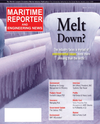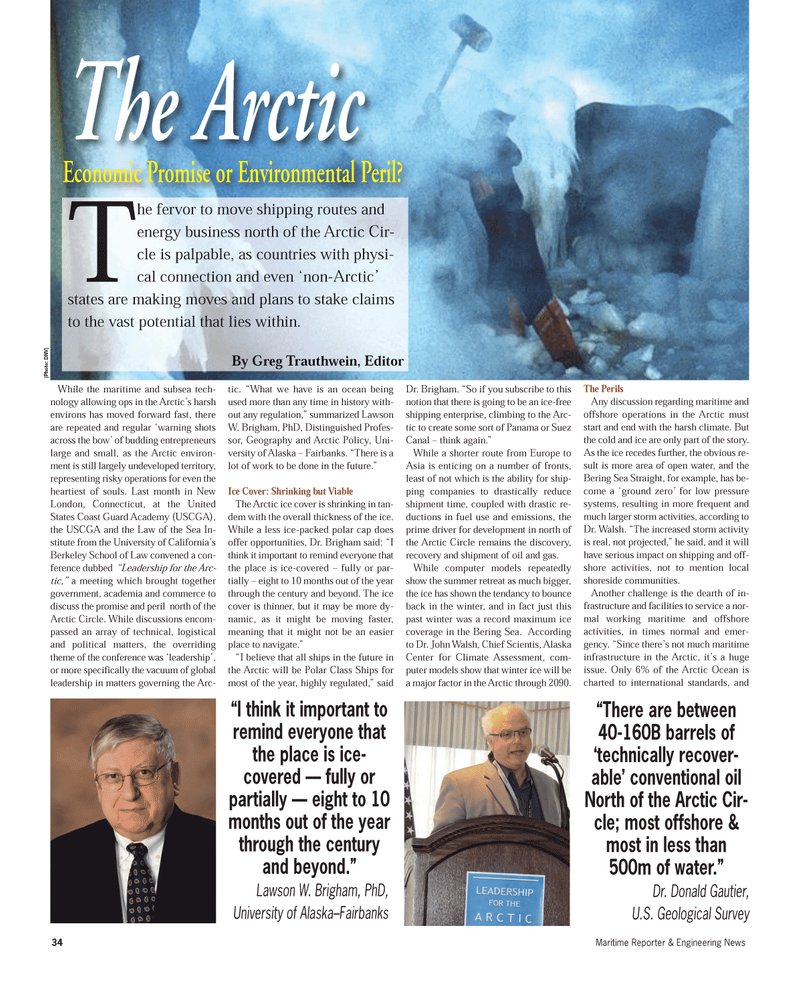
Page 34: of Maritime Reporter Magazine (May 2012)
The Green Ship Edition
Read this page in Pdf, Flash or Html5 edition of May 2012 Maritime Reporter Magazine
While the maritime and subsea tech-nology allowing ops in the Arctic?s harsh environs has moved forward fast, there are repeated and regular ?warning shots across the bow? of budding entrepreneurs large and small, as the Arctic environ- ment is still largely undeveloped territory, representing risky operations for even the heartiest of souls. Last month in New London, Connecticut, at the UnitedStates Coast Guard Academy (USCGA), the USCGA and the Law of the Sea In- stitute from the University of California?s Berkeley School of Law convened a con- ference dubbed ?Leadership for the Arc- tic,? a meeting which brought togethergovernment, academia and commerce to discuss the promise and peril north of theArctic Circle. While discussions encom- passed an array of technical, logisticaland political matters, the overriding theme of the conference was ?leadership?, or more specifically the vacuum of global leadership in matters governing the Arc- tic. ?What we have is an ocean being used more than any time in history with- out any regulation,? summarized Lawson W. Brigham, PhD, Distinguished Profes- sor, Geography and Arctic Policy, Uni- versity of Alaska ? Fairbanks. ?There is a lot of work to be done in the future.? Ice Cover: Shrinking but Viable The Arctic ice cover is shrinking in tan- dem with the overall thickness of the ice. While a less ice-packed polar cap does offer opportunities, Dr. Brigham said: ?I think it important to remind everyone that the place is ice-covered ? fully or par- tially ? eight to 10 months out of the yearthrough the century and beyond. The ice cover is thinner, but it may be more dy- namic, as it might be moving faster, meaning that it might not be an easierplace to navigate.? ?I believe that all ships in the future in the Arctic will be Polar Class Ships for most of the year, highly regulated,? said Dr. Brigham. ?So if you subscribe to this notion that there is going to be an ice-freeshipping enterprise, climbing to the Arc- tic to create some sort of Panama or Suez Canal ? think again.? While a shorter route from Europe toAsia is enticing on a number of fronts,least of not which is the ability for ship-ping companies to drastically reduceshipment time, coupled with drastic re-ductions in fuel use and emissions, theprime driver for development in north of the Arctic Circle remains the discovery, recovery and shipment of oil and gas. While computer models repeatedlyshow the summer retreat as much bigger, the ice has shown the tendancy to bounce back in the winter, and in fact just this past winter was a record maximum ice coverage in the Bering Sea. According to Dr. John Walsh, Chief Scientis, Alaska Center for Climate Assessment, com- puter models show that winter ice will be a major factor in the Arctic through 2090. The Perils Any discussion regarding maritime and offshore operations in the Arctic must start and end with the harsh climate. Butthe cold and ice are only part of the story. As the ice recedes further, the obvious re- sult is more area of open water, and the Bering Sea Straight, for example, has be- come a ?ground zero? for low pressure systems, resulting in more frequent andmuch larger storm activities, according to Dr. Walsh. ?The increased storm activity is real, not projected,? he said, and it will have serious impact on shipping and off- shore activities, not to mention local shoreside communities.Another challenge is the dearth of in-frastructure and facilities to service a nor- mal working maritime and offshore activities, in times normal and emer- gency. ?Since there?s not much maritime infrastructure in the Arctic, it?s a huge issue. Only 6% of the Arctic Ocean is charted to international standards, andThe Arctic Economic Promise or Environmental Peril? (Photo: DNV)The fervor to move shipping routes and energy business north of the Arctic Cir- cle is palpable, as countries with physi- cal connection and even ?non-Arctic? states are making moves and plans to stake claims to the vast potential that lies within. By Greg Trauthwein, Editor ?There are between 40-160B barrels of ?technically recover- able? conventional oilNorth of the Arctic Cir- cle; most offshore & most in less than500m of water.? Dr. Donald Gautier, U.S. Geological Survey34Maritime Reporter & Engineering News ?I think it important to remind everyone that the place is ice-covered ? fully or partially ? eight to 10 months out of the yearthrough the century and beyond.?Lawson W. Brigham, PhD, University of Alaska?Fairbanks MR May 12 # 5 (34-41):MR Template 5/8/2012 9:45 AM Page 34

 33
33

 35
35
